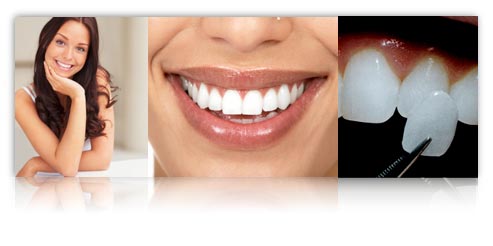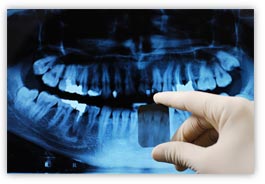Dental veneers are custom-made ultra-thin shells of tooth-colored materials designed to cover the front surface of teeth to improve your appearance.
The veneers are bonded adhesively to the front of the tooth to fix the look of teeth that are chipped, discolored, misaligned, uneven, worn down, or abnormally spaced.
Veneers are a cosmetic dentistry procedure that creates a bright, white smile with beautifully aligned, shapely teeth.
Veneers are constructed of porcelain or from resin composite materials.
Porcelain veneers are thought to be more natural looking as they better mimic the light reflecting properties of natural teeth and are known for their abilities to resist stains.
Your cosmetic dentist will be able to help you decide which choice is right for your particular needs.
What Dental Problems can Veneers Solve?
Dental veneers can make most issues concerning unattractive teeth better, including worn enamel, wear and tear, genetics, and uneven teeth.
Over time the protective layer that covers our teeth called enamel becomes worn down, gets duller, and becomes discolored. This is often the result of genetics but may also be attributed to diet and the food and drinks that stain our teeth.
The natural wear of teeth occurs as we get older and results in a less aesthetically pleasing appearance. Our teeth are more prone to chipping and cracking, and veneers may be recommended to remedy this occurrence.
 Additionally, veneers have been known to provide benefits to the following:
Additionally, veneers have been known to provide benefits to the following:
- Crooked teeth
- Chipped teeth
- Cracked teeth
- Spaced teeth
- Discolored teeth
- Misshapen teeth
- A braces alternative
In addition to being utilized as a cosmetic dentistry procedure, veneers can also serve a functional purpose by protecting the surface of a damaged tooth.
Often time’s dental veneers can eliminate the need for more invasive tooth preparation, such as the need for a dental crown. The thin nature of veneers requires little to no tooth reshaping to bond them to the tooth.
Dental Veneers Procedure




A dental veneer procedure usually takes three trips to the dentist- the first for the initial consultation and two to make and install the veneers.
One tooth or many teeth can simultaneously undergo the application process as described below.
Dental offices typically offer amenities for those undergoing procedures that take elongated periods of time such as the ability to watch TV, listen to music, or relax.
Initial Consultation- The initial consultation is between you and your dentist to discuss the result that you wish to achieve.
Your dentist will perform a full examination and evaluation of your teeth to make sure dental veneers are appropriate for you and discuss what the procedure will involve and some of its limitations.
Your dentist may also take x-rays and make impressions of your mouth and teeth.
Preparation- On your next visit to your dentist, he/she will remove about 1/2 millimeter of enamel from the tooth surface, which is an amount nearly equal to the thickness of the veneer to be added to the tooth surface.
A use of a local anesthetic may be used to numb the area before the enamel is trimmed off. Then your dentist will make a model or impression of your tooth to send out to a dental laboratory which will be constructing your veneer.
This process usually takes 1 to 2 weeks for your dentist to receive the veneers back from the laboratory.
Application- On your third and final visit, your dentist will temporarily place the veneer on your tooth to examine its fit and color before it is permanently attached.
To achieve the proper fit, your dentist will repeatedly remove and trim the veneer as needed. Before the veneer is bonded to your tooth, your tooth will be cleaned, polished, and roughened to allow for a strong bonding process.
To properly affix the veneer to your tooth, the dentist will apply a special light beam to the veneer which activates chemicals in the bonding cement that cause it to cure very quickly.
Finally, all excess bonding cement is removed, your bite is evaluated and any final adjustments are made to the veneer as necessary.
You will probably be asked to return for a follow-up visit to ensure the veneer placement has been successful and to check how your gums are responding to the presence of your veneer(s).
Pros and Cons of Dental Veneers
Dental Veneers offer the following advantages:
- Provide a natural looking appearance
- Gum tissue tolerates porcelain well
- Porcelain veneers are stain resistant
- Veneers don’t require extensive shaping procedures
- The color of veneers can improve upon that of dark teeth
The disadvantages to dental veneers:
- Veneers are permanent
- Veneers cost more than composite resin bonding
- Veneers may not repairable should they become damaged
- They may temporarily cause your teeth to become more sensitive because of the removal of enamel
Cost of Dental Veneers
There are many factors associated with the cost of dental veneers including who your dentist is, where you live, the extent of your procedure, and the materials used.
Generally, veneers can range in cost from $500 to $1,300 per tooth. Some dental insurance companies may cover some of the costs associated with veneers however this is not common because veneers are generally considered a cosmetic dentistry procedure.
Check with your dental care provider to see if they will help with the cost of your dental veneers.
Other factors that influence the cost of dental veneers include:
- The artistic and technical skill of the ceramist making the veneers.
- The material used, whether porcelain or resin composite.
- The number of teeth involved in the procedure.
- Any additional restorative or cosmetic dentistry procedures necessary to prepare for veneers such as teeth whitening, or tooth reshaping.
Veneer Alternatives
There are alternatives to dental veneers and you can discuss these with your dentist to determine which ones may or may not be appropriate to you. The choices include bonding and crowns.
Dental Bonding- Dental bonding is applying a tooth-colored resin to the tooth to restore it from the effects of wear and tear, aging, decay, spacing, and more.
The process is similar to that of veneers, however, there are no veneers applied, the resin itself is used to shape the tooth to its desired profile.
Dental Crown- Dental crowns are a tooth-shaped “cap” that is placed over a tooth to restore its shape and size, and to improve its appearance. They are cemented into place and are typically permanent restorations of teeth.

Lumineers
Lumineers are the most popular of what are called minimal preparation and “no-prep” ceramic veneer options.
The difference in these types of veneers is that they typically do not require the dentist to grind, cut down, or file any tooth structure for proper placement.
Additionally, there is no need for shots because Lumineers do not require any drilling of sensitive teeth structure.
Lumineers last over 20 years with proper care and allow you to eat and drink whatever you want. Additionally Lumineers, unlike traditional veneers, are reversible because there is no penetration into the layer of tooth substance beyond the enamel.
